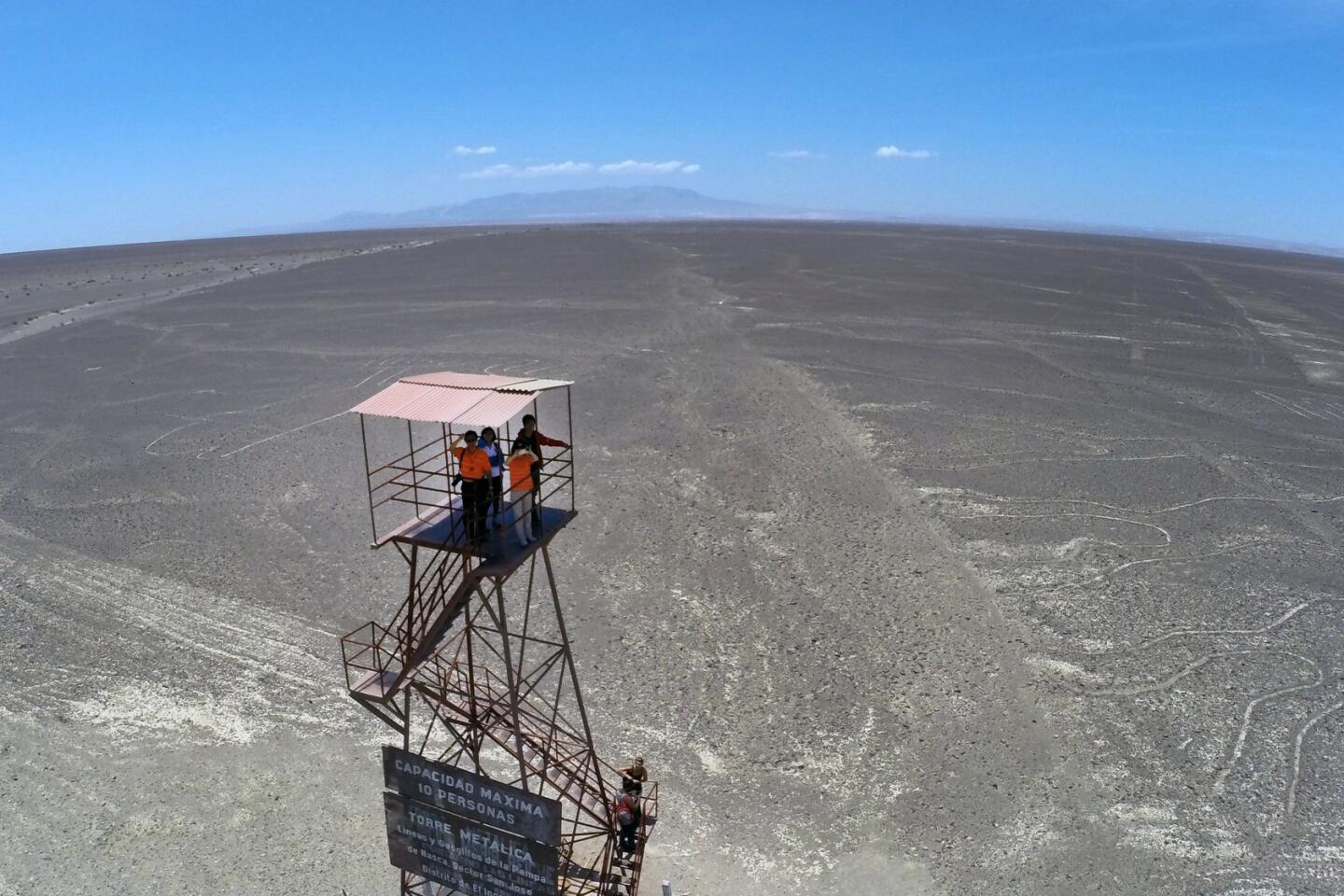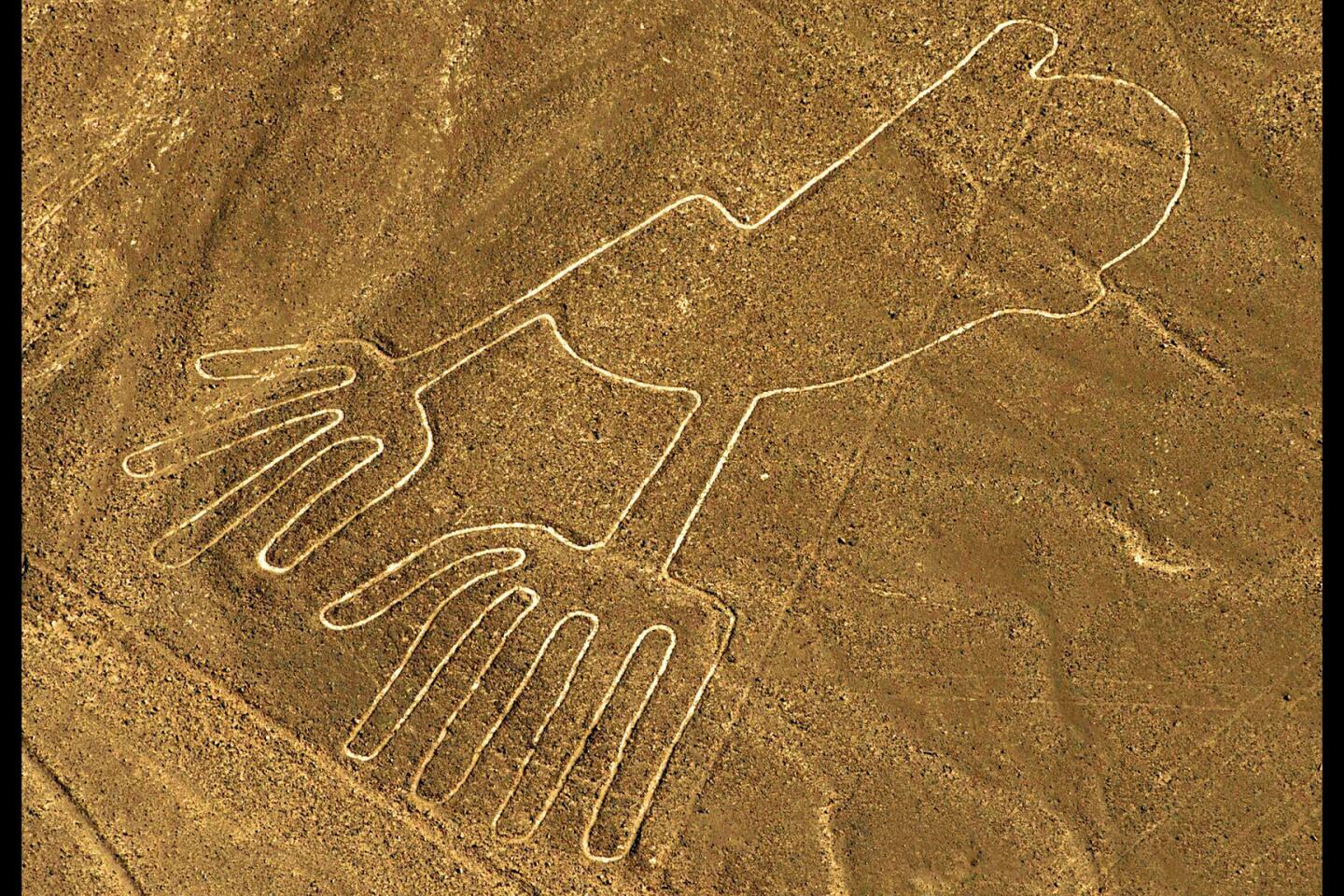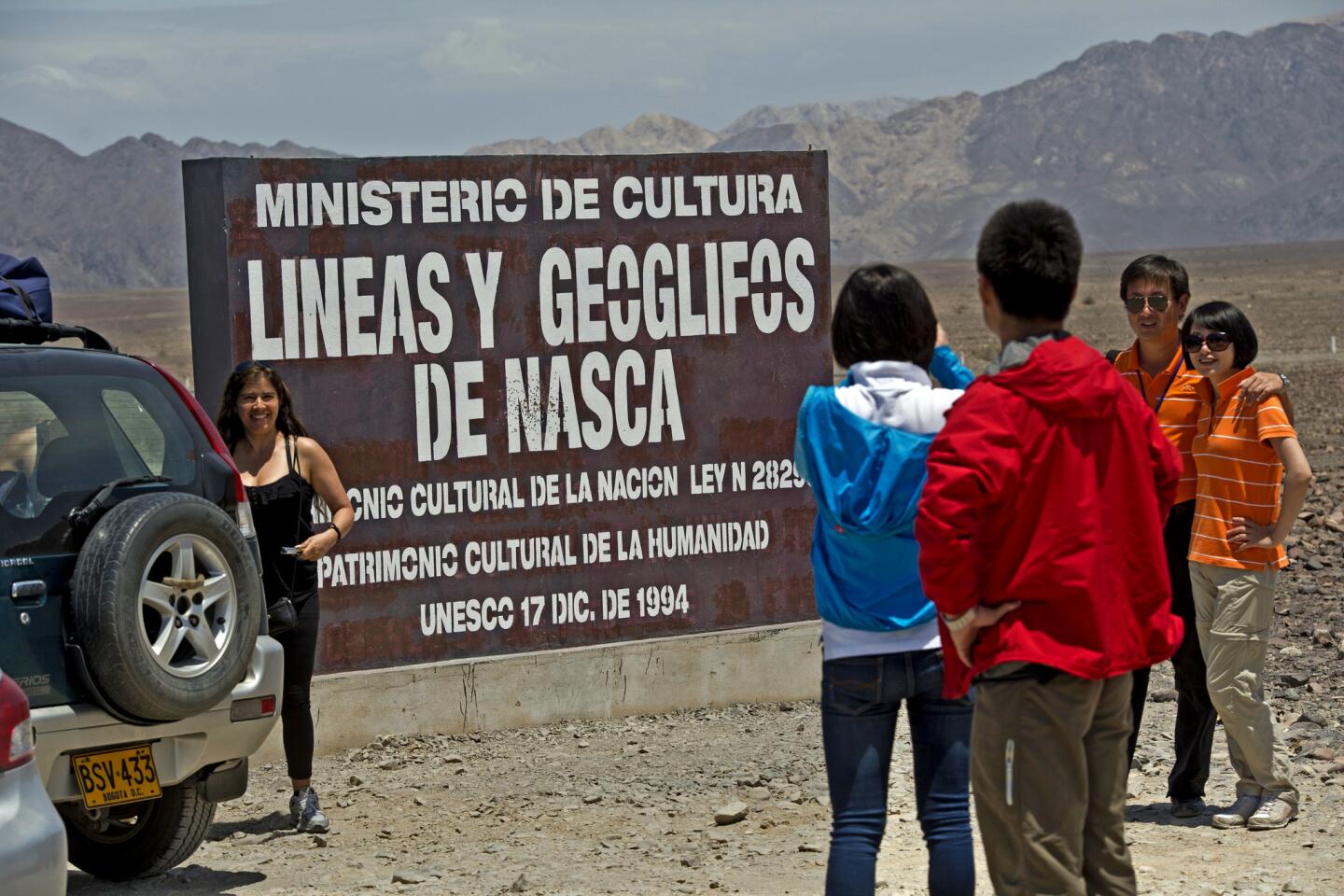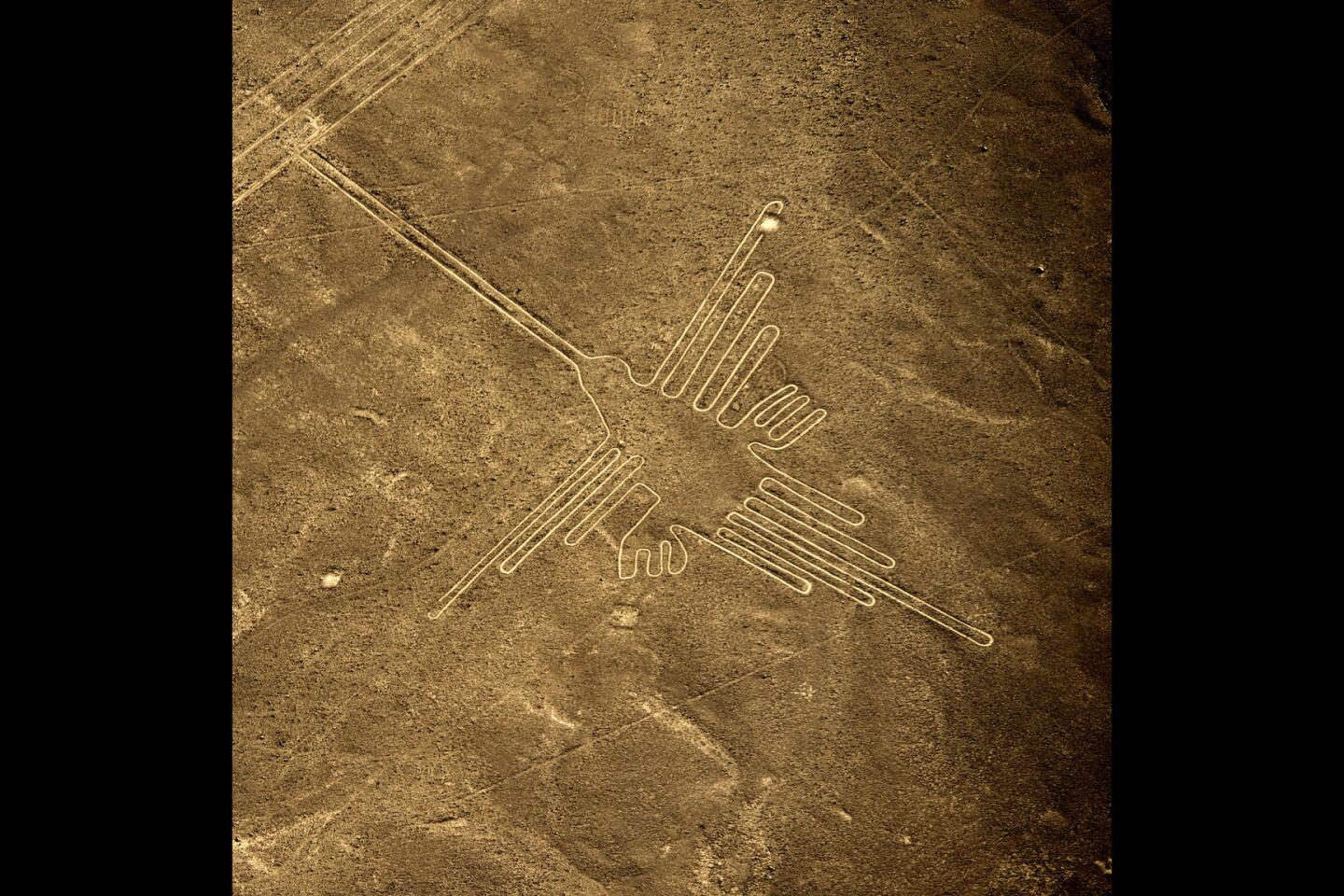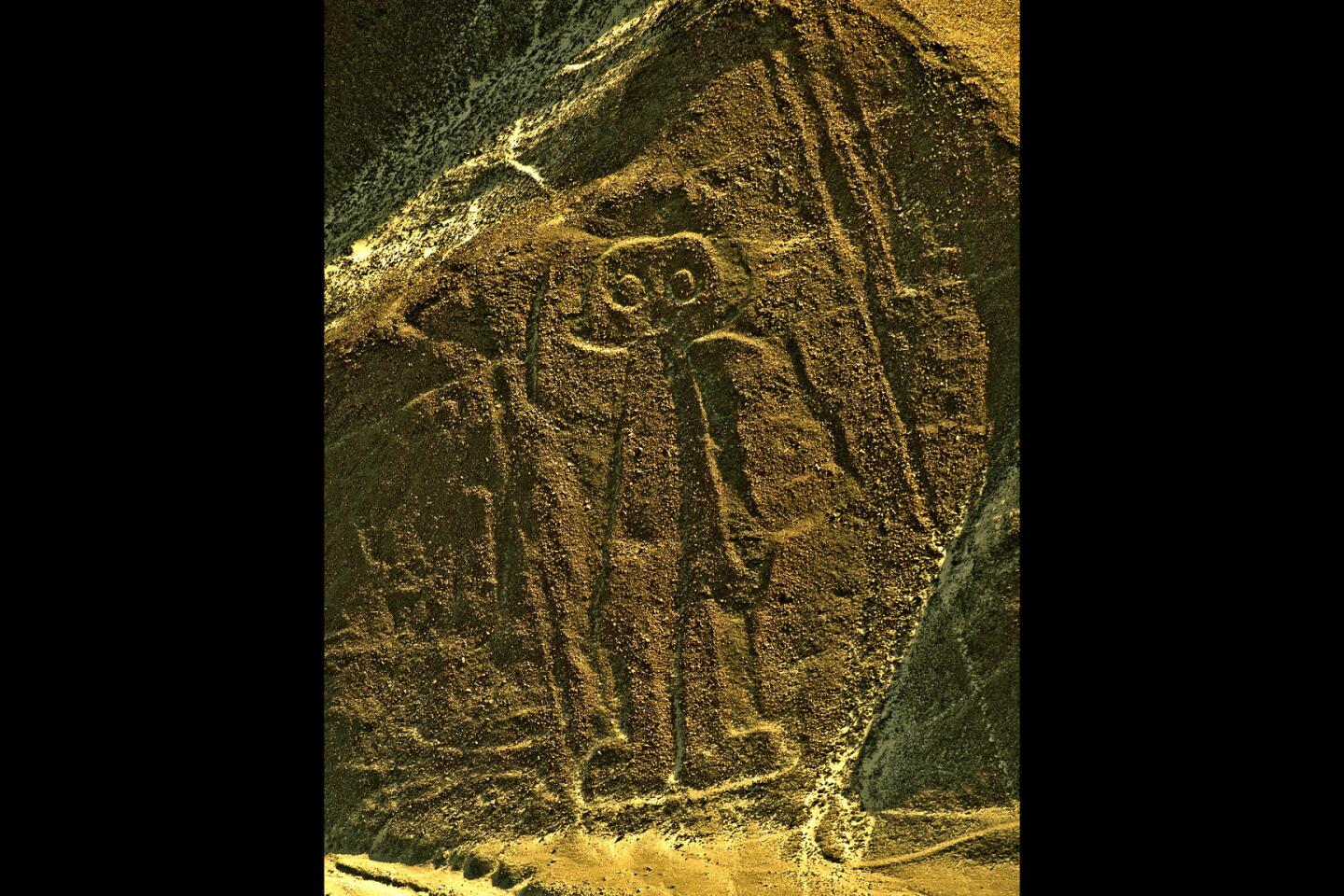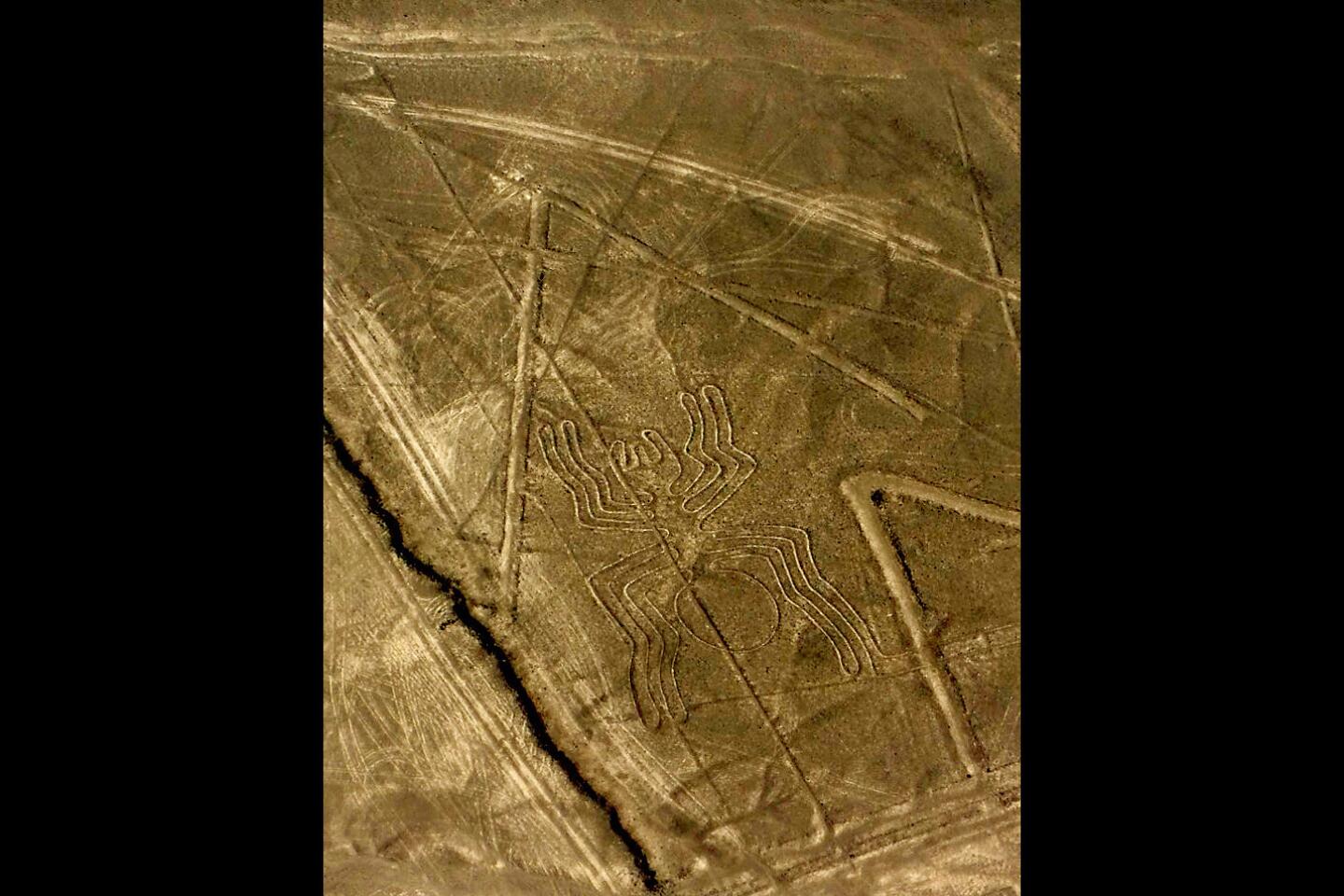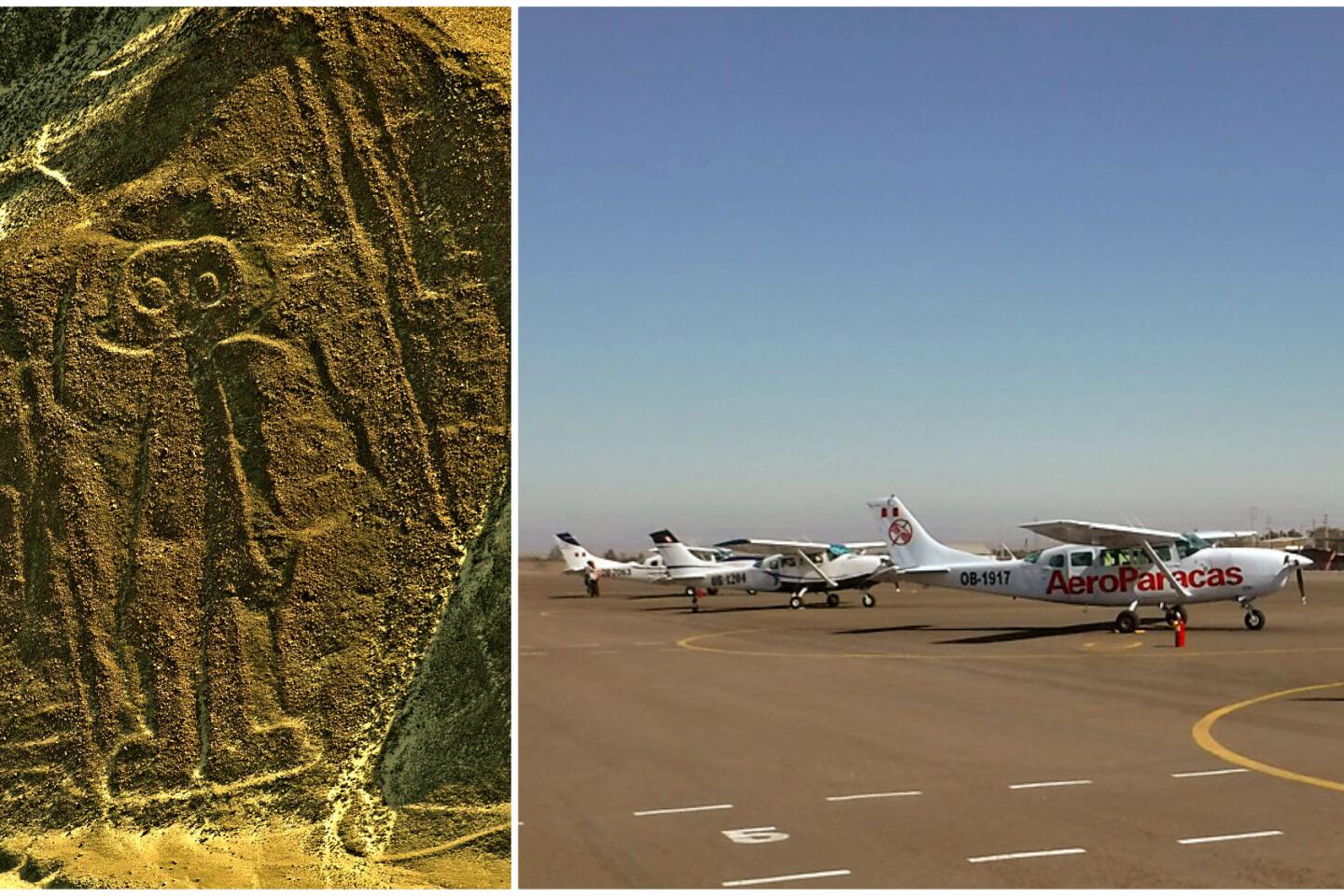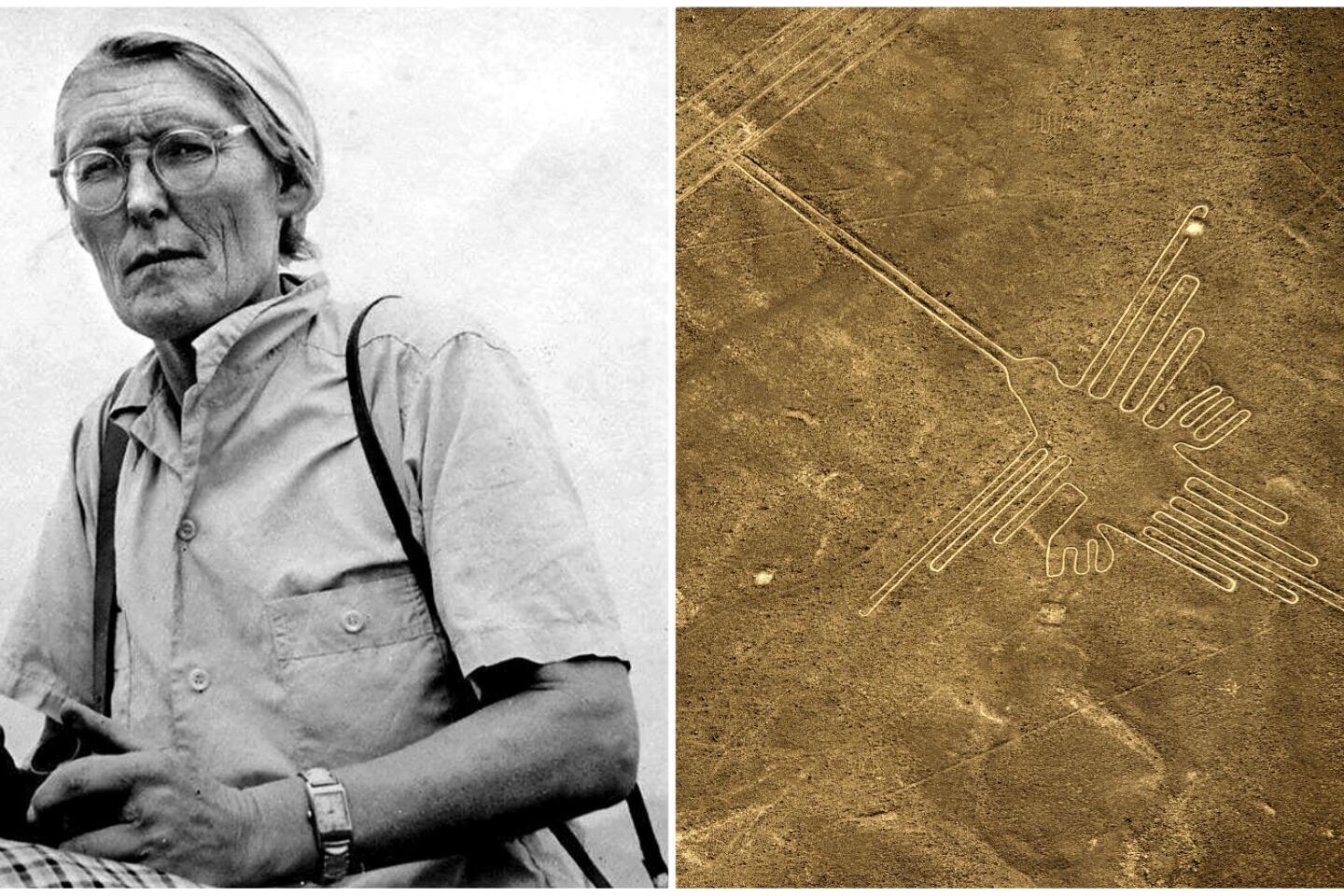The Nazca Lines of Peru: An ancient riddle etched in the earth makes for a perfect family adventure
- Share via
NAZCA, Peru — You look at the massive collection of lengthy grooves and geoglyphs in the bone-dry desert of southern Peru, and you know immediately they are one of the great unsolved mysteries of this Earth.
Why are they here? What message are these 300 geometric figures and 70 plant and animal images supposed to convey? What prompted the Nazca people to create them by removing stones from the darkened desert floor to reveal lighter-colored soil beneath?
For many people, they’re a puzzle. For me, they represented an adventure that had long beckoned. Together with my sons, Theo, 12, and Benji, 10, and my husband, Jonathan, we headed south in June to explore the Nazca Lines, a riddle whose origins date back more than 2,000 years.
Peruvian archaeologist Toribio Mejia Xesspe brought the lines to the world’s attention in 1927 when he spotted them during a hike in the nearby hills.
But it was not until 1939, when a team of researchers flew over the desert, that anyone recognized that some of the lines formed the shapes of animals.
There are a condor, a hummingbird, a monkey, a dog, a spider and a lizard, among others. Mathematicians, archaeologists, scientists, hippies, con men, dreamers and tourists have been drawn here, creating a cottage industry of Nazca Line theorists.
Maria Reiche, a German mathematician who spent her life fighting to preserve the lines, thought they were an astronomical calendar. Some archaeologists think they were created by a cult that begged the gods to bring water to this arid region, which receives only about an hour of rain a year.
There are anthropologists who believe they were used as huge running tracks for part of a ritual. And Swiss author Erich von Däniken believes that the lines were messages to aliens and that the desert was a giant extraterrestrial airport.
A tower on the Pan-American Highway north of Nazca offers a sketchy view of the lizard, tree and frog, but the only way to see the figures clearly is from the air.
There have been flights over the lines since 1978; as the lines became more popular, the number of flyovers proliferated. In 2008, a crash occurred and five French tourists were killed. In 2010, two planes crashed in 12 months, killing 13 people.
Now there are eight airlines and two pilots per plane. Engines in the planes must be replaced every 1,000 hours. Every flight does the same prescribed 30-minute route for the same price ($80). The planes depart from Maria Reiche Neuman Airport outside Nazca at least six minutes apart at staggered altitudes. There have been no accidents in the last five years. I thought the flight was safe enough to take my family.
We flew into Lima, Peru, and set off from there. Nazca is an eight-hour bus ride from Lima — and there is no way around it. Many upscale Lima hotels offer marathon one-day trips that start at 3 a.m. and return late the same day. You can also hire a taxi to take you to Nazca for about $500 round trip.
We decided to make our Nazca adventure part of a larger trip, adding archaeological sites and a visit to a desert oasis. We bought the best seats on the luxury bus and settled in for the ride.
::
From the air, the Nazca Lines are magnificent and powerful
We rose early for our flyover of the Nazca Lines, waiting our turn at the tiny airport, really just a landing strip in the desert.
We were excited, but I did hesitate briefly after hearing someone upchucking in the restroom. We had heard that the flights could be stomach-churning. Guidebooks advise to get into the air early because winds pick up in the afternoon.
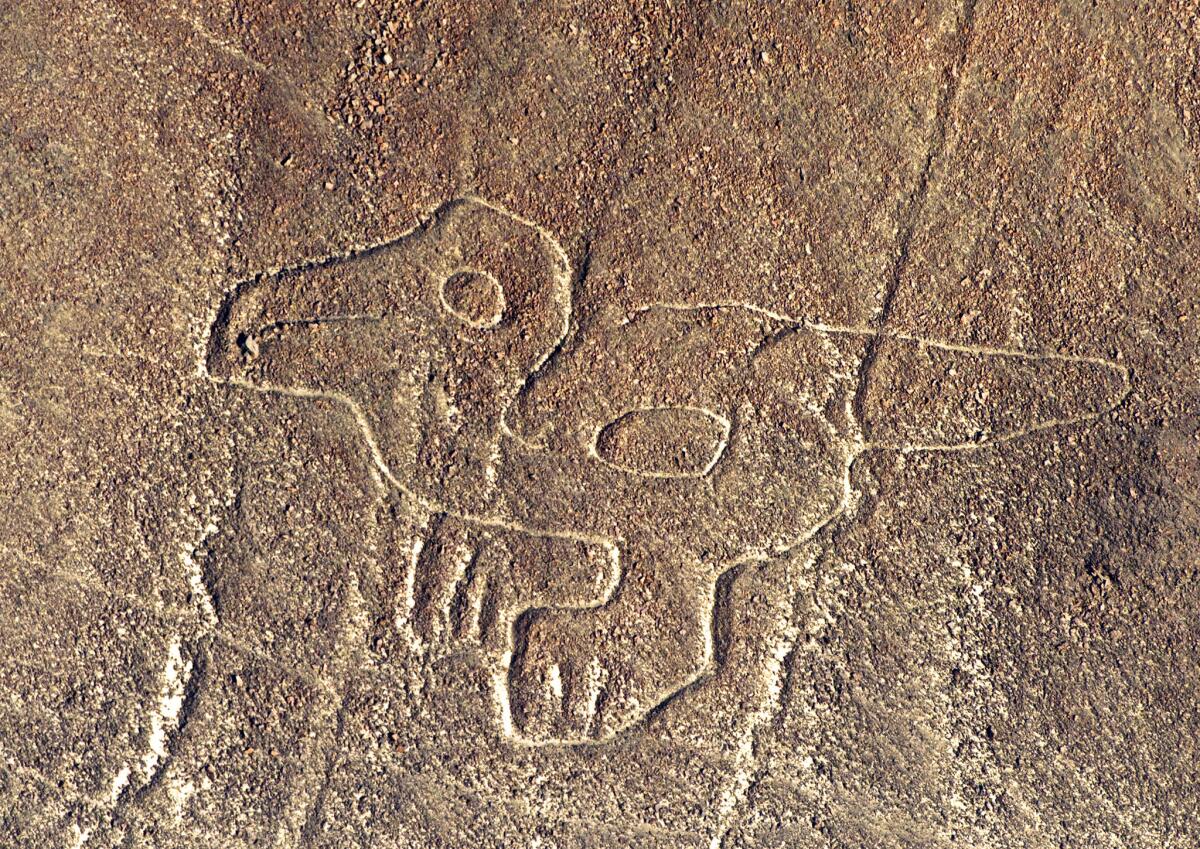
An aerial view of a geoglyph representing what appears to be a bird.
Each flight carries four to six people, plus two pilots, so the ride is hot and tight. The inside of our plane felt smaller than our Volvo station wagon. The airsickness bags were tucked discreetly into the seat backs in front of us.
But once we took off, none of that mattered.
At first, the lines were hard to see; they are less distinct than in the airbrushed postcards sold in every store in town.
The whale, first on the circuit, and the oldest at an estimated 2,500 years, was the hardest to make out. The pilot banked the plane to the right to allow a glimpse and photos, then to the left, so passengers on the other side of the plane had a clear view.
Some of the subtle designs were bright and clear, others so faint I missed them completely. There were no do-overs.
Still, to see these ancient figures in the sand — even if you are hot and slightly nauseated — is unforgettable. They are so magnificent, and you stand in awe of those who made them. You know they are messages from people of the past, but what were they trying to say? As you fly over them, you feel their insistence, their power.
It haunts me still.
::
Near the Nazca Lines, another mystery: the Cantalloc aqueducts
The mysteries don’t stop with the Nazca Lines. Add to that the riddle of the Cantalloc aqueducts.
The aqueducts were about a five-minute taxi ride from our hotel in Nazca, so we headed out of a town on a rutted road, crossing a dry, bumpy riverbed, to the site. It was discovered in 2000 and is newly excavated.
About 17 aqueducts have been dug out; locals think there are more. Each is designed in a downward spiral, the universal sign of Pachamama, or Mother Earth, in South America. You can walk down the spirals; at each base, you can see a cool underground stream that links the aqueducts.
There were no guides — just a woman at the gate to take the 10 sol (about $3) entry fee.
Another woman standing under a tree said she thought the Inca had built the aqueducts to carry water from the mountains to nearby fields that still exist. The way the spirals are built, you could dam one to create a bath. Or they could be used as a series of sacred pools for a religious ceremony.
They are beautiful, ingenious and as amazing as any Roman ruin. We eavesdropped on a few local guides leading tourist groups, and they all told different stories.
Another mystery.
::
If you go
THE BEST WAY TO LIMA, PERU
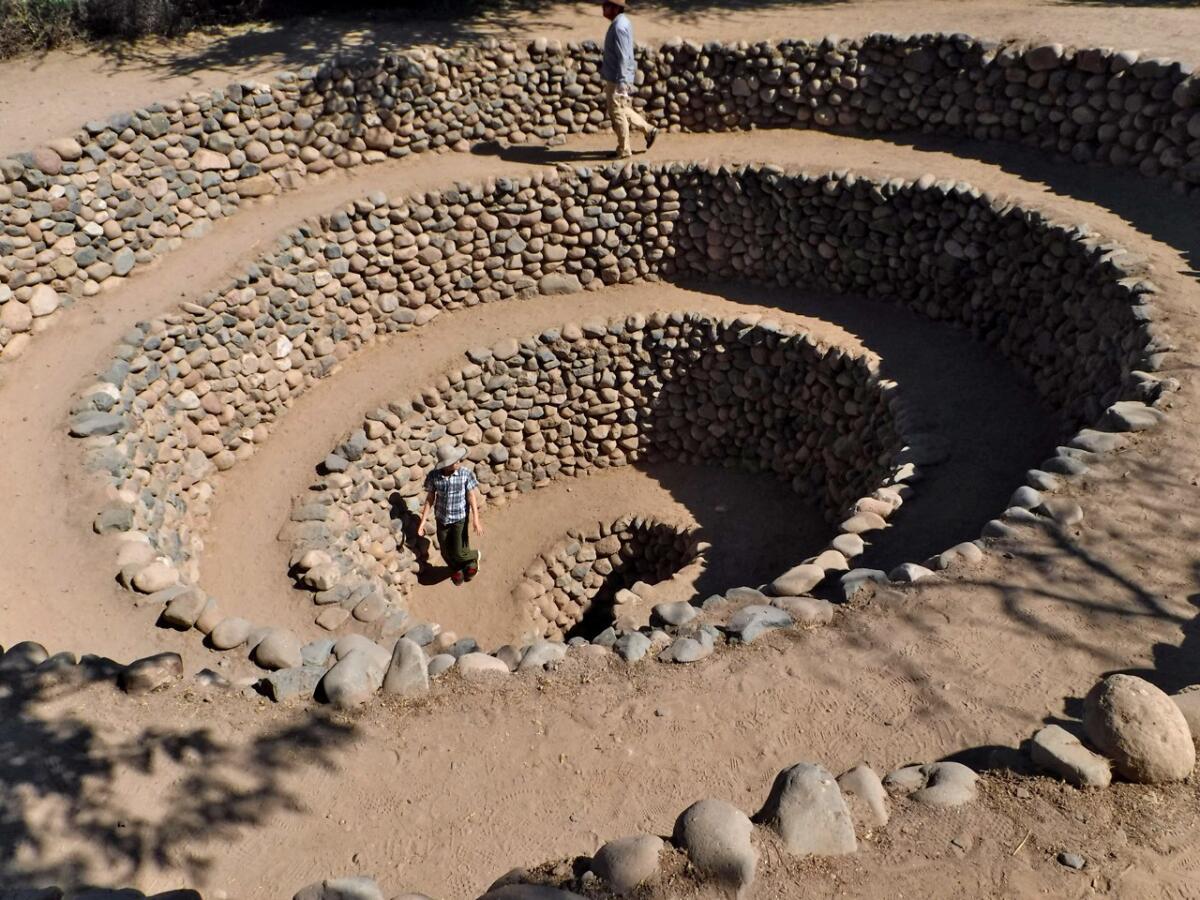
Another mystery in this area of Peru: the Cantalloc aqueducts, which spiral to an underground stream.
From LAX, LAN offers nonstop service to Lima, and Avianca, Copa, Delta, American, Aeroméxico and United offer connecting service (change of planes). Restricted round-trip fares from $938.
Plan on spending the night in Lima and then getting an early start for Nazca, an eight-hour bus ride away. Cruz del Sur and Ormeño have luxury bus lines that run daily from Lima to Nazca. It is worth paying about $30 one-way per person for the top class for more reclining room, a snack and a movie. Book a Nazca Lines flyover through your hotel or a travel agency in town. AeroParacas (www.aeroparacas.com) and Alas Peruanas (www.alasperuanas.com/en/) offer reliable flights for $80, though all airlines charge the same rate and fly the same route.
TELEPHONES
To call the numbers below from the U.S., dial 011 (the international dialing code), 51 (the country code for Peru) and the local number.
WHERE TO STAY
Nazca Lines Hotel, Jiron Bolognesi, Nazca; 56-52-2293, www.peru-hotels.com/nazlines.htm. This beautiful hotel has rooms arranged around a peaceful courtyard and pool. There is a nightly show at the on-site planetarium. Doubles from $103, including breakfast.
Casa Andina, 367 Jiron Bolognesi, Nazca; 56-52-3563, www.casa-andina.com/classic-nazca/?lang=en. This recently renovated hotel in the center of town offers stylish rooms and modern furnishings. Doubles from $153, including breakfast.
Hotel Mossone, Balneario de Huacachina, Huacachina; 56-21-3630. This once-luxurious hotel has the best location in town but has seen better days. Doubles from $114, including breakfast.
WHERE TO EAT
Nazca Lines Hotel (see above). Nice restaurant with a view of the pool and central courtyard, a fine pisco sour and an international menu.
Via La Encantada, 282 Jiron Bolognesi, Nazca; www.hotellaencantada.com.pe/restaurante/index.html. The best restaurant in Nazca, with good wine and excellent European and Peruvian dishes.
Hoy: Léa esta historia en español
TO LEARN MORE
About Peru, www.peru.travel/en-us. To find out more about Nazca, click on Ica.
More to Read
Sign up for The Wild
We’ll help you find the best places to hike, bike and run, as well as the perfect silent spots for meditation and yoga.
You may occasionally receive promotional content from the Los Angeles Times.
